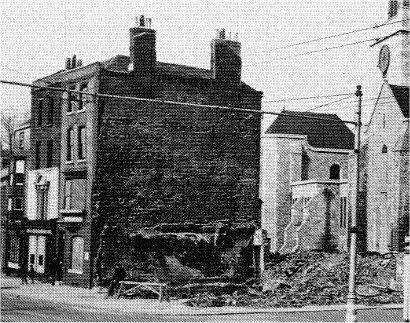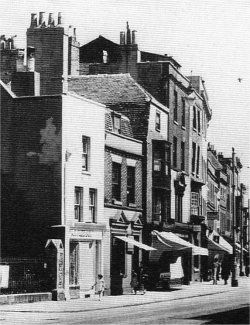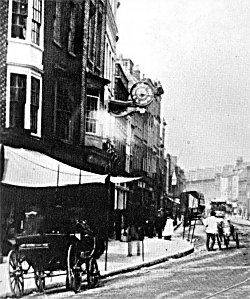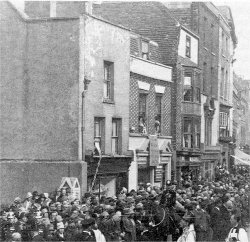
Nos. 98 - 102 High Street

This group of buildings were the most northerly to have originally been sited in front of the Cathedral (St. Thomas's Church). They spanned the distance between the narrow access to the church between Nos. 97 and 98 and the eastern end of Golden Lion Lane (now Lombard Street).
There exist very few really useful images of these buildings and those that have survived are either too late or at such an acute angle as to make interpretation difficult. What they are certainly able to tell us is that many of these structures changed significantly between 1842 and the 20th century, but as usual they cannot be very precise about the date of any changes. Compounding our problem is the fact that in 1869/70 Golden Lion Lane was widened to allow through traffic from Portsea to Southsea. In the process the building to the south of the entrance to the lane, No. 102, was largely demolished. Further information is available on our page on the widening of Golden Lion Lane.

The four remaining buildings survived in one form or another until World War II, when all were damaged; No. 101 was largely destroyed by a bomb on 10/11 January 1941 when 12 people lost their lives. A memorial plaque now marks the spot where stood No. 101 High Street. The remaining three buildings stood until around 1955 when they were demolished to give a totally uncluttered view of the Cathedral from High Street. The photograph on the left must be one of the last to have been taken of these buildings. The photograph below, right, was taken from the opposite direction, between the world wars, probably in the 1930s. Although rather acute it allows us to confirm that Nos. 98-100 were largely the same structures as were depicted in the Charpentier drawing. The only change above ground floor level seems to be the loss of a first floor bay window to No. 99. There is insufficient detail of No. 101 to enable any conclusion to be drawn about the configuration of the facade but we can deduce that it is not the same building as in the 1842 drawing - it is too tall, higher even that No. 100.

Moving back 50 years we find another photograph from much the same position and although it still doesn't tell us much about No. 101 it does confirm that the changes to the building, which can be seen in the image below, left, with a large clock projecting from the front, took place before 1880. One further image taken in 1868 (see bottom left) contains a sliver of No. 102, just large enough to show that it was a tall four story building as it was in the Charpentier drawing.
From the 1861 OS map we can determine the widths of Nos 98-101 to be 16'0", 20'10", 18'2" and 32'10" respectively. It is not possible to measure the width of No. 102 from the OS Maps we have been using as they were modified in 1874 and therefore show Golden Lion Lane as it appeared after the widening. Only a fraction of No. 102 remains and it's not clear whether it should be considered to be a separate building or part of No. 101.
Fortunately, original copies of the 1861 map do still exist, though not in as good a condition as the later version. From this it is possible to show that the original width of No. 102 was 24'0" whilst it's modified width was only 6'6". This map also shows the corner to have been rounded to a significant degree, but of course this would only have applied at ground level and if we look carefully at the Charpentier drawing we can see that the shop doorway on the corner must have been angled at approximately 45 degrees, thus providing the rounding effect.

Looking at No. 98 we see in all images an asymmetric front face with the top left hand edge angled at 35 degrees. Of course it is possible that it was built this way but an alternative suggestion is that the building was originally symmetrical with the cut away showing on both sides and that at a later date No. 99 was extended to the left. The problem with this explanation is that it would have left the bay windows well off centre, unless they were moved at the same time as the encroachment by No.99.
A further curiousity about No. 98 is the height of the signage fascia and the cornices above and beneath it. Charpentier shows this to have been rather narrow whereas the 1927 photograph (bottom right) shows it some three times that height. The only way the later version could have been accommodated is if the base panel of the lower bay window was shortened and that is exactly what can be seen. Once again we have no definitive information about the configuration of the shop front in 1860. We do know however that No. 98 had formerly been an inn by the name of the Eight Bells which in 1716 had been presided over by Mr. Ragg. Stephen Pomeroy suggests that it continued in this role until 1845 but this runs counter to the Charpentier drawing which shows a Pork Butchers at that location.
Nos. 99 and 100 seem to have retained the same structure from 1842, probably right through to their demolition in the 1950s. One issue of doubt is the first floor bow window to No. 99 which was replaced by a pedimented sash window in later years, however, it is present in the 1880 photograph and so must have been in the 1860s.
There is very little useful information about either No. 101 or 102. We do know that in both cases the buildings shown by Charpentier were changed dramatically by the 1880s. In the case of 102 we know that that change occurred in 1869/70 when Golden Lion Lane was widened, but this means that the only evidence we have is that from Charpentier. In 1842, No. 101 appears to have been essentially two buildings, at least two tenants are shown associated with the one building in the drawing from that date, but the directories list only one occupant suggesting that the change had occurred before 1860. Certainly by the time of the 1875 photograph No. 101 had been replaced by a four storey building
Documentary Evidence
Post Office Directory (1859) - Thomas Batchelor, bookseller, bookbinder & stationer, 98 High Street; George Fowler, hairdresser and perfumer, 99 High Street; Frederick Hordle, ironmonger, 100 High Street; Henry Lewis, bookseller, printer and stationer, 102 High Street.
Kelly's (1859) Directory - Thomas Batchelor, bookbinder, bookseller and stationer, 98 High Street: George Fowler, hairdresser and perfumer, 99 High Street; Frederick Hordle, ironmonger, 100 High Street; Emanuel E., optician, goldsmith, jeweller, silversmith, watchmaker, 101 High Street; Henry Lewis, bookseller, printer and stationer, 102 High Street; J.T. Ubsdell, Life and Fire Offices, 102 High Street.
Harrod's (1865) Directory - Miss Sarah Hill, Berlin wool depository, 98 High Street; George Fowler, hairdresser and perfumer, 99 High Street; Frederick Hordle, ironmonger, 100 High Street; Emanuel E., goldsmith, jeweller, silversmith, watchmaker, 101 High Street; Henry Lewis, bookseller, printer and stationer, 102 High Street.
The 1861 Census records:-
Schedule 87 - Thomas Batchelor (33, bookseller, bookbinder & stationer), his wife Mary (28) and Margaret Lowe (16, servant)
Schedule 88 - George Fowler (40, perfumer), his wife Elizabeth (39), their children Helen (18), Eliza (16), George (13)b Merina (12), Helner (10), Adolphus (8), Henry (6), Edwin (18 months) and Eliza Phillips (17, servant) and a lodger.
Schedule 89 - Frederick Hordle (38, ironmonger), his wife Mary (24), his daughter Edith (3) and Fanny Clarke (16, servant). There is also a second household recorded under this schedule, namely William Suter (27, tailor's assistant) and his wife Amelia (26).
Schedule 90 - Emanuel Emanuel (62, goldsmith), his wife Julia (47), son Emanuel (21), daughter Kate (16), son Maurice (14), son Edward (10) with Sarah Bray (27, servant) and Fanny Reston (32, servant)
Schedule 91 (Deposit Bank) - John Ubsdell (63, Bank Manager), Ann Wallis (39, housekeeper)
Schedule 92 - Thomas Lewis (22, bookseller) and Rebecca Bartlett (62, housekeeper)
These census entries generally accord with the information from the directories but there are two departures from the standard records so far observed. In the first, Sch. 89 lists two households and in the second, two Schedules (91/92) cover the occupants of one property (102 High Street). The most significant name to appear on this list is that of Emanuel Emanuel who with David Levy at No. 65 High Street represented the foremost members of the Jewish Community in Portsmouth.
Summary

Numbers 98 to 100 High Street appear to have retained the same structure throughout the period under examination. Whether No. 98 suffered a truncation as suggested earlier is irrelevant as far as the model is concerned as we know that apart from the shop, about which we know little, there is no substantial change and can be modelled as such. The fascia and cornices of the shop are shown clearly on the 1927 photograph (right) and in the absence of better evidence will be assumed to have been present since the 1860s. The shop windows will be structured as in the Charpentier drawing but with plate glass extending over the full height.
The bow window at first floor level on No. 99 was removed at some point after the period of the model but the photo from the 1880s shows that it was present up until at least that date. The photo also confirms the evidence from Charpentier that the bow is made up of just two sash windows rather than the usual three. The evidence for the rest of the property is similar to No. 98.

Charpentier and the photos up to 1927 all seem to agree that No. 100 has experienced a minimal amount of alteration which is surprising in one respect, namely, that the height of the ground floor (to the top of the fascia cornice) is over 13 feet which is a lot for a standard Victorian shop. This building is the only one for which we have evidence of the roof structure (see the post-war photo).
All three of these buildings have brick facades, but whilst Nos. 98 and 99 can be guessed at with some accuracy there are no clear indications for No. 100 apart from the fact that it appears significantly lighter than it's neighbour. The brickwork could easily be a weathered yellow, and that is what the model will portray.
No. 101 is a real problem. The photographic evidence, such as it is, suggests that the building shown by Charpentier had been replaced by a taller four story building by 1875. As both 101 and 102 had been owned by Emanuel Emanuel at the time of the widening of Golden Lion Lane and, bearing in mind that there had been very little left of 102 after the widening, it seems likely that Emanuel would have used this occasion to combine both buildings into a more modern structure. This would imply that the buildings shown in the Charpentier drawing were probably still in existence throughout most of the 1860s. The census returns more or less confirm this view as in Charpentier No. 101 is divided into two businesses, the left hand one being that of a tailor, the census having listed a second household (William Suter, tailor) under Schedule 89. It would appear that the enumerator misunderstood with which property the tailoring business should be associated. Thus No. 101 will appear as in Charpentier which is our only evidence for it's appearance. We do have to be careful however over the width of this building, Charpentier has made it appear somewhat wider than the 1861 OS Map tells us it should be.
The 1868 photo with the narrow slice of No. 102 (see left) is sufficient evidence to tell us that the structure in place at that time was the same as that shown in Charpentier. As there were two entrances to the ground floor shop area it can be assumed that Messrs Ubsdell and Lewis each had their own entrance. The model can safely depict No. 102 with large plate glass windows and the same weathered yellow brickwork seen on No. 100. The same photo also gives some indication of the width of Golden Lion Lane before widening, there seeming to be very little space between Nos. 102 and 103.